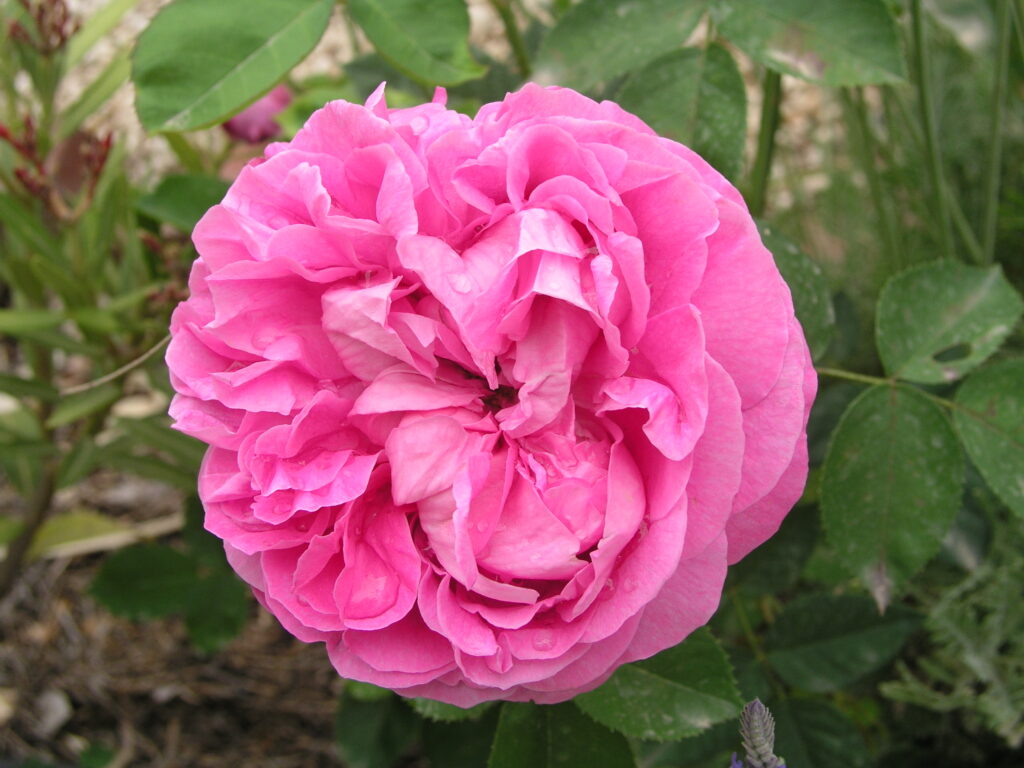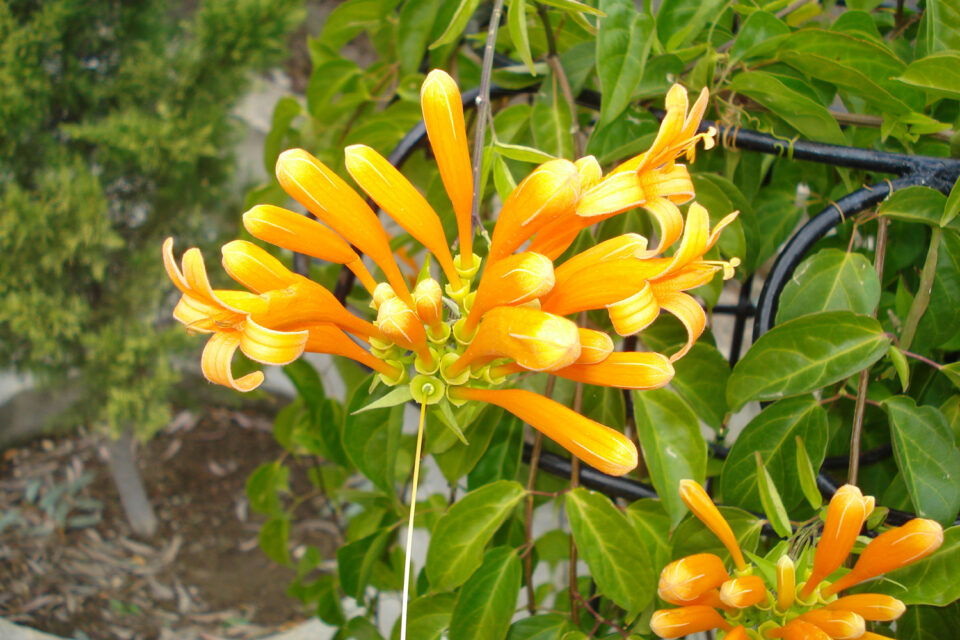However there is always something to admire
Gardeners are weather watchers. For them it can be too cold, too hot, too wet or too dry and there is always something to worry about. So I didn’t need the Met Men to report that we had had the coldest, wettest winter ever this year. The garden is still recovering and looking back through date-stamped photos we are about three weeks later than usual, but catching up fast!
Over the past few years we have had April heat waves when the temperatures have pushed 30C, way too high for that time of year for the emerging buds and flowers. The result of that was that citrus flowers and tiny fruits were burned off before they got going.
Last winter all the rain we had that soaked the ground encouraged growth everywhere and this year we are able to enjoy many more flowers on the trees and in the flower beds, as well as masses of verdant weeds!
Alas, annual flowers like sweet peas and cerinthe amongst many others whose roots are close to the surface, become dried up very quickly once the sun is out, although many perennials and trees with deeper roots can survive.
So in order to have a pleasing year-round garden it is necessary to have some really hot weather plants to plug the gaps, as well as those that can also take some cold if you live higher up from the coast.
Looking around my garden I see the lovely bay tree known as Daphne with its heavenly perfumed flowers just dying off amongst the very dark-green, useful leaves, which is always worth a space. (See Plant of the Month.)
The rosemary hedge always seems to give off its perfume all year round and is another plant that can survive weather fluctuations. Pyrostegia from Brazil is currently wrapping its curling tendrils over and round a standard blue vine tree (Lycianthes rantonnetii) in an almost beguiling manner, the orange flowers complimenting the blue of the host plant. Those very useful aloes, Aloe vera, are pushing up their lemon flowering stems, to give a bright glow to any dry banks – so lots to enjoy,
WHAT TO DO IN THE GARDEN THIS MONTH
With temperatures rising rapidly this month lots of the tiny new fruits of prunus fruits like plums and apricots fall off the trees. This is known as the ‘spring drop’. It is mostly caused by fluctuating night and day temperatures and/or strong winds and these vulnerable little fruits would not have survived anyway. Fruit trees need feeding again this month. If you can get 20.10.10 fertiliser then use one mugful for small trees and three mugsful for mature trees. This time round you may have to water the fertiliser in around the base area of the trees as there may be no rain to help you out.
Watch out for signs of the Asiatic Citrus Leaf Miner Moth that may have laid its eggs inside the leaves earlier and when hatched the grub quickly disfigures them by making tunnels inside. We tried hanging bags of mothballs amongst the branches of the trees, which is an old remedy, but with little effect I am afraid. Keep an eye out also for greenfly and blackfly now and use a soapy water spray to get them off your plants. They will be on your roses for sure and sometimes attack the new foliage of citrus and prunus trees as well. There are several things on the market to try, but the best thing is to run your fingers, latex gloved of course, down the stems, but watch out for rose thorns!

May is certainly the month for roses in Cyprus. Village gardens are full of bright colour as they vie with each other to be the brightest and the best! After a slow start my Banksia rose is looking stunning as it roams all along the fence line between us and the ‘green land’. Just along the road from me is a garden full of what is known here as ‘hundred petal’ roses, tightly petalled roses in a gorgeous pink which exude a wonderful perfume as you pass by. Their botanical name is Rosa × centifolia, but they are usually known as the ‘Provence Rose’, ‘Cabbage Rose’ or ‘Rose de Mai’. This attractive pink rose was developed by Dutch breeders in the period between the 17th century and the 19th century, possibly earlier, and you thought that the Dutch only bred tulips!
Some figs, pomegranates and bay trees are particularly prone to throwing up suckers around their bases and if you let them grow they will weaken the tree. Remember that jacaranda trees will flower first if they have been deprived of water but if they have been watered or rained on regularly during the winter, they will burst into leaf before a single gorgeous flower cluster appears. They also grow extremely tall so think where you are going to plant them before you are tempted to buy one for your own garden.
Dead-head flowers regularly or they will set seed and stop sending up new flower buds. Some flowers like osteospermums droop when the sun goes in and if you dead head in the evening you may nip off viable flowers, so make that a morning job. Cut back dead freesia heads and pick sweet peas as they come into flower and enjoy them indoors. Regular cutting may encourage them to continue blooming for some time to come.
With such a choice in the garden centres it is sometimes difficult to know what to choose that will survive in your garden or pots during the hot summer months. Grey foliaged plants or those with felted reverses to their leaves such as gazanias and rosemarys are able to exist on minimum watering and in excessive heat, so are a good choice. I changed over my canna lilies to growing them in pots quite a few years ago now but attractive as they are, they do need regular watering to look anything, coming as they do from tropical America.
I grow more drought-tolerant tulbaghias from South Africa which are extremely popular plants these days and used frequently in urban plantings. Kniphofias, commonly known as ‘Red Hot Pokers’, are sometimes available with their torch-like flower stems, although I did grow some from seed with bright yellow flower heads some years ago. One of my favourite summer plants is hemerocallis, or the ‘day lily’. It is a very popular plant in the US and more varieties are being imported into Cyprus giving a better choice of shape and colour, other than the bright orange ones to be seen in cottage gardens here. In the garden centres they will be in full bloom now, but it may take a little longer for those in your garden to catch up. Remember that plants in the tunnels of garden centres and sheltered retail areas are not subject to the vagaries of the weather and will be well ahead of those in your garden.
Plant of the Month Laurus nobilis
Laurus nobilis is also known by its common names of ‘bay tree’, ‘true laurel’, ‘sweet bay’ or ‘Grecian laurel’ and can be grown as a tree or a large shrub. In some countries it is sometimes known as ‘Daphne’ due to its associations with Greek mythology. It is a very handsome tree when mature and an asset to have in any garden. The dried leaves make a welcome addition to cooking in many households around the world.
This aromatic evergreen plant with smooth green leaves is native to the Mediterranean region. It will thrive in well-drained soil in full sun to partial shade. It grows slowly and can been used as a hedge or as a topiary but beware, in the right conditions it can reach heights of between 10-16 metres. In domestic gardens it can be kept to a reasonable height by pruning. In pots it needs to be brought indoors during the winter in order to prevent frost damage.

Laurel has a tendency to throw out suckers around the root area, but apart from that it is a very easy tree to maintain. Wind scorch can occur on young foliage in the early part of the year, whilst some cracking of the bark of the trees can be caused by over-watering; although in their natural state they are found to be growing near streams and springs. In the springtime lovely sweetly-perfumed cream flowers appear in clusters of between three to five blooms, followed later by a black drupe – a one seeded berry.
Laurel leaves were widely used as a symbol of honour, when poets and other people of renown were crowned by laurel leaves – hence the term Poet Laureate.
Use it as a small tree in an herb garden, or plant several for a screen or a privacy hedge. Its evergreen leaves and fissured dark gray bark make it an excellent choice as a specimen for shady locations and also makes for good winter interest.


